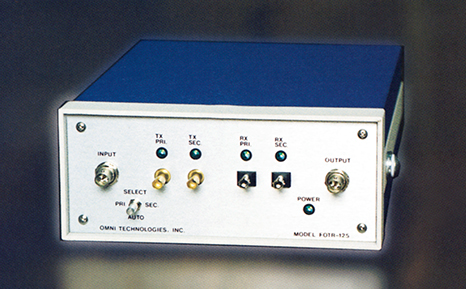Data Goes the Distance
NASA's lead center for rocket propulsion testing, Stennis Space Center, has always faced the dilemma of collecting accurate data from the inherent hostile environment of rocket engine tests. It is essential, however, to be able to test and predict the behavior of the Space Shuttle Main Engine during its eight and one-half minute flight toward orbit. Unfortunately, remote recording of high-speed digital data has been impossible because of various technological and bandwidth constraints. For this reason, NASA sought a way to collect propulsion test data accurately.
When NASA began looking for such a method, the system developed not only provided a safe solution, it also served as a shot in the arm for a small Louisiana business. Omni Technologies, Inc., of New Orleans, Louisiana, worked with Stennis on the development of the FOTR-125—a redundant fiber-optic transceiver for the remote transmission of high-speed digital data.
Initially, data collection involved methods that either posed the risk of corrupting the test data or were very time-consuming. In one method, signals were transmitted from the test stand to a safe processing and data recording location over long copper lines. These signals could become corrupt though pickup of electromagnetic noise from the environment. In another method, analog signals were tape recorded on the test stand, and the tapes were then moved to a safe place, which required extra time to digitize and process the data after the tests. Data could also be lost if the test stand was damaged or destroyed during the test. The ideal solution would be to digitize the analog signal on the test stand and then immediately transmit this digital data for recording in a safe location.
To solve the problem of remote recording of digital data, NASA Test Operations at Stennis and Omni developed a 125-megabit-per-second fiber-optic transceiver. The fiber-optic transceiver was designed as a cost-effective solution for long-distance, duplex data communications between the Racal Tape Transport Unit (TTU), or recorder, and the Signal Processing Unit (SPU), or digitizer. The fiber link allows a user to separate the TTU and SPU over greater distances. Each FOTR-125 accepts a customized interface developed by NASA engineers for both input and output. The fiber-optic link can be as long as 25 km (15.54 miles) with the connection of two transceiver units, much longer than the standard coaxial link, which can be no longer than 50 meters (164 feet).
According to NASA officials, Stennis chose Omni Technologies for the co-development of the transceiver because of the company's experience and expertise with similar fiber optic applications. Once the work was completed, the NASA Technology Applications Team at the Research Triangle Institute assessed the technology's potential in the commercial marketplace. Omni Technologies has an exclusive license to the technology and has sold the unit. The FOTR-125 is being marketed to anyone who is gathering large amounts of data. The company has had success with such applications as undersea data acquisition and plant floor data acquisition. The unit can be used in extremely hazardous testing as well, such as explosives, ordnance, nuclear, and some combustion turbine engines.

Omni Technologies, Inc.'s FOTR-125 is a redundant fiber-optic transceiver for the remote transmission of high-speed digital data.













